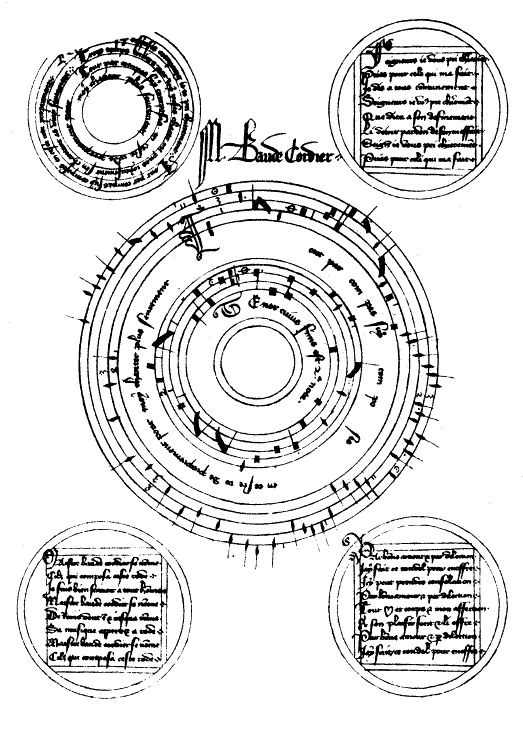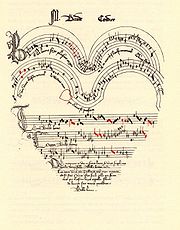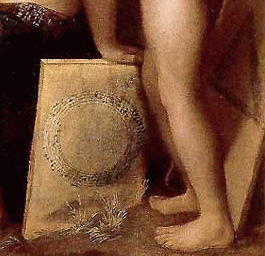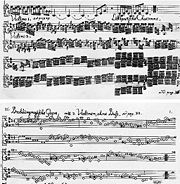
Eye music
Encyclopedia
Eye music describes graphical features of score
s that when performed are unnoticeable by the listener.
, and representations of melody and form depends on the relationships of composer, performer, and listener.
works such as puzzle canons, which appear in the score entirely as a bare line of notes with clefs, rest
s, time signature
s, or key signatures as clues to reveal multiple lines of music in canon. (Closer to true cryptographic works would be those with soggetto cavato, where letters are embedded in the work using their solfege
names.) As an example, a puzzle canon might be notated as one line of music with two key signatures and clefs, where the worked-out result will be a two-voice canon with one voice the retrograde (reverse) of the other. In itself the score with the clues alone is not eye music. But represent the same work "graphically spelled out," however, say with a drawing of the clued score facing a mirror, and the score/drawing becomes eye music.
The type of puzzle canon is also a factor. A four-voiced circular canon, when notated as a puzzle canon, may remain an un-worked-out single line of notes, and be inadmissible as eye music. When that single line of notes is inscribed in a graphical shape it becomes eye music, even if the contrapuntal
puzzle remains unsolved.
An even finer use of graphical conceit is when the canon does not have any musical way to end, and are in a sense "infinite"—classically referred to as canon perpetuus, more commonly as "circular canons," and even more commonly as "rounds
." When an infinite (circular) canon is inscribed in a circle, and the circle itself is a clue that means "play me as a round," a different type of eye music entails.
's cantata Stravaganze d’amore, the continuo
part is written entirely in enharmonic
chords, that is, "puns" of chord indications spelled with no regard to the key of the rest of the ensemble, but (in equal temperament
) indistinguishable audibly from those spelled in the appropriate way. Here, the perverse spelling (whether humorous or annoying to the trained continuo player) is not unusual graphically, but represents a score writing unmotivated except as an inside joke between composer and performer, and is unhearable by the listener.
The Gulliver Suite by Telemann discussed below, shows a combination of three eye music features. The score is made difficult "unnecessarily," is eye-catching for its graphics, and has a clever external reference, all unnoticeable to the listener.

 Two examples of eye music from the early Renaissance are from Baude Cordier
Two examples of eye music from the early Renaissance are from Baude Cordier
, (ca. 1380-ca.1440). Cordier's chanson about love Belle, bonne, sage is in a heart shape, with red notes (coloration) indicating rhythmic alterations. Eye-music-within-eye music is in the small group of notes hanging like a locket in the upper left, also all in red and in the shape of a heart. Another work of Cordier, this time inscribed in circles, Tout par compas suy composés ("With a compass was I composed"), goes out of its way to identify itself as eye music.
Josquin des Prez
, the most important composer of the next generation, used black note notation eye music in his well-known Nymphes des bois, a lament over the death of the composer Ockeghem, as well as another lament, this time for the composer Obrecht
, Absolve, quaesumus, Domine.
It can be seen that words of death and lament are associated with black notes, a mannerism
made even simpler to achieve in light of the contemporaneous simplification to white note notation. This feature of eye music would extend through the Humanist
period.
 Another instance of eye music in the Renaissance is apparently unique—the representation of a triangle for a canonic piece, which appears in juxtaposition with an anonymous canon written in a circle—in Dosso Dossi
Another instance of eye music in the Renaissance is apparently unique—the representation of a triangle for a canonic piece, which appears in juxtaposition with an anonymous canon written in a circle—in Dosso Dossi
's Allegory of Music. It is possible that the two types of representation—the circle and the inherent symbolism of the tenets of Christianity in the triangle—are both suggestive of a sense of the infinite. The work represented in the triangle, is part of a "rough" version of a puzzle canon in Josquin's Agnus Dei II from his Missa L'homme armé super voces musicales
canonic mass. It has the superscript "trinitas in un[um]" ("three in one") as a clue to its solution, is a mensuration canon of 3:1, and has one voice take part at the interval of a fifth, that is, 3:2. Its relation to the Christian Holy Trinity is clear, suggesting the use of a triangular representation. The representation is unique, although possibly from a copy used by Dossi.
 With the significant shift of style of composers of the Humanist
With the significant shift of style of composers of the Humanist
movement—the rediscovery and translation of Greek texts in the mid-16th century—eye music flourished. The change in musical practice, particularly with the madrigalists
and their focus on text declamation, at a word-by-word basis, was fertile ground for eye music. Words that suggest "blackness," such as "death" or "night," receive "black" notes (e.g. quarter note
s, eighth note
s; "white words" such as "light" or "pale" receive "white" notes (e.g. whole note
s, half note
s).
With the Italian madrigalists from the 1580s until the early 17th century (whose style was almost literally imported to England), eye music reached its apogee until its transformation in the 20th century. Luca Marenzio
is considered the composer most fond of eye music. For example, in the madrigal Senza il mia sole from his Madrigali a quattro, cinque e sei voci (1588), black notes are used for "chiuser le luci" ("close their eyes")
Reaction by theorists of the time was mixed. A leading musical humanist, Vincenzo Galilei
(the father of the physicist), was opposed to it but Zarlino approved. In the 20th century, Alfred Einstein, a groundbreaking scholar of the Humanist madrigal, wrote that eye music is "the most extreme and (for our aestethic convictions) most horrible testimony of naturalism, of imitazione, in the madrigal."
 In Telemann's Gulliver Suite for two violins the note values in the chaconne
In Telemann's Gulliver Suite for two violins the note values in the chaconne
are "Lilliputian
," and, in the gigue
, in "Brobdingnagian"
ones. Because the Lilliputian movement is marked with the equally bizarre time signature
of 3/32, and the Brobdingnagian one in 24/1 (which is doubly humorous because gigues are generally light and brisque), the time signatures reduce to 3/4 and 9/8, perfectly normal ones for each movement, as are the tempos associated with them and the type of dance of each.
.
are not, in fact, a feature of eye music. As novel and attractive as the graphics may be in these scores, they function entirely as performance indications or true records of compositional method (such as the Steiner score shown here). Also often seen are graphical or conceptual art
works that that use the symbols of music notation but are not performing scores at all, such as Erwin Schulhoff
's 1919 In futurum (Zeitmaß-zeitlos).

Sheet music
Sheet music is a hand-written or printed form of music notation that uses modern musical symbols; like its analogs—books, pamphlets, etc.—the medium of sheet music typically is paper , although the access to musical notation in recent years includes also presentation on computer screens...
s that when performed are unnoticeable by the listener.
Difficulties in defining eye music
A clear definition of eye music is elusive, for the border between eye music, word paintingWord painting
Word painting is the musical technique of writing music that reflects the literal meaning of a song. For example, ascending scales would accompany lyrics about going up; slow, dark music would accompany lyrics about death.Tone painting of words goes at least as far back as Gregorian chant...
, and representations of melody and form depends on the relationships of composer, performer, and listener.
Eye music and word painting
To a person well-versed in the style of Baroque music, word painting is, as intended, noticed. An example of word painting is when "upward" octave jumps accompany the word "arise." But someone unused to Baroque musical style may not appreciate that musical "effect" - to them they are merely notes and lyrics. In this case, word painting is no longer the issue. For them, the "leaps" of written notes are unhearable, but are visible only to the composer or performer: a definition of eye music.Eye music and puzzle-solving
The difficulty in definition is also apparent with border-line cryptographic contrapuntalCounterpoint
In music, counterpoint is the relationship between two or more voices that are independent in contour and rhythm and are harmonically interdependent . It has been most commonly identified in classical music, developing strongly during the Renaissance and in much of the common practice period,...
works such as puzzle canons, which appear in the score entirely as a bare line of notes with clefs, rest
Rest
Rest may refer to:* Leisure* Human relaxation* SleepRest may also refer to:* Rest , a pause in a piece of music* Rest , the relation between two observers* Rest , a 2008 album by Gregor Samsa...
s, time signature
Time signature
The time signature is a notational convention used in Western musical notation to specify how many beats are in each measure and which note value constitutes one beat....
s, or key signatures as clues to reveal multiple lines of music in canon. (Closer to true cryptographic works would be those with soggetto cavato, where letters are embedded in the work using their solfege
Solfege
In music, solfège is a pedagogical solmization technique for the teaching of sight-singing in which each note of the score is sung to a special syllable, called a solfège syllable...
names.) As an example, a puzzle canon might be notated as one line of music with two key signatures and clefs, where the worked-out result will be a two-voice canon with one voice the retrograde (reverse) of the other. In itself the score with the clues alone is not eye music. But represent the same work "graphically spelled out," however, say with a drawing of the clued score facing a mirror, and the score/drawing becomes eye music.
The type of puzzle canon is also a factor. A four-voiced circular canon, when notated as a puzzle canon, may remain an un-worked-out single line of notes, and be inadmissible as eye music. When that single line of notes is inscribed in a graphical shape it becomes eye music, even if the contrapuntal
Counterpoint
In music, counterpoint is the relationship between two or more voices that are independent in contour and rhythm and are harmonically interdependent . It has been most commonly identified in classical music, developing strongly during the Renaissance and in much of the common practice period,...
puzzle remains unsolved.
An even finer use of graphical conceit is when the canon does not have any musical way to end, and are in a sense "infinite"—classically referred to as canon perpetuus, more commonly as "circular canons," and even more commonly as "rounds
Round (music)
A round is a musical composition in which two or more voices sing exactly the same melody , but with each voice beginning at different times so that different parts of the melody coincide in the different voices, but nevertheless fit harmoniously together...
." When an infinite (circular) canon is inscribed in a circle, and the circle itself is a clue that means "play me as a round," a different type of eye music entails.
Eye music for the performer
Another class of eye music is when the score is purposely made difficult for the performer. For example, in Benedetto MarcelloBenedetto Marcello
Benedetto Marcello was a Venetian composer, writer, advocate, magistrate, and teacher.-Life:...
's cantata Stravaganze d’amore, the continuo
Figured bass
Figured bass, or thoroughbass, is a kind of integer musical notation used to indicate intervals, chords, and non-chord tones, in relation to a bass note...
part is written entirely in enharmonic
Enharmonic
In modern musical notation and tuning, an enharmonic equivalent is a note , interval , or key signature which is equivalent to some other note, interval, or key signature, but "spelled", or named, differently...
chords, that is, "puns" of chord indications spelled with no regard to the key of the rest of the ensemble, but (in equal temperament
Equal temperament
An equal temperament is a musical temperament, or a system of tuning, in which every pair of adjacent notes has an identical frequency ratio. As pitch is perceived roughly as the logarithm of frequency, this means that the perceived "distance" from every note to its nearest neighbor is the same for...
) indistinguishable audibly from those spelled in the appropriate way. Here, the perverse spelling (whether humorous or annoying to the trained continuo player) is not unusual graphically, but represents a score writing unmotivated except as an inside joke between composer and performer, and is unhearable by the listener.
The Gulliver Suite by Telemann discussed below, shows a combination of three eye music features. The score is made difficult "unnecessarily," is eye-catching for its graphics, and has a clever external reference, all unnoticeable to the listener.
The Renaissance


Baude Cordier
Baude Cordier was a French composer from Rheims; it has been suggested that Cordier was the nom de plume of Baude Fresnel. Cordier's works are considered among the prime examples of ars subtilior...
, (ca. 1380-ca.1440). Cordier's chanson about love Belle, bonne, sage is in a heart shape, with red notes (coloration) indicating rhythmic alterations. Eye-music-within-eye music is in the small group of notes hanging like a locket in the upper left, also all in red and in the shape of a heart. Another work of Cordier, this time inscribed in circles, Tout par compas suy composés ("With a compass was I composed"), goes out of its way to identify itself as eye music.
Josquin des Prez
Josquin Des Prez
Josquin des Prez [Josquin Lebloitte dit Desprez] , often referred to simply as Josquin, was a Franco-Flemish composer of the Renaissance...
, the most important composer of the next generation, used black note notation eye music in his well-known Nymphes des bois, a lament over the death of the composer Ockeghem, as well as another lament, this time for the composer Obrecht
Obrecht
Obrecht is the name of:* Jacob Obrecht , Franco-Flemish composer of the Renaissance* Hermann Obrecht , Swiss politician...
, Absolve, quaesumus, Domine.
It can be seen that words of death and lament are associated with black notes, a mannerism
Mannerism
Mannerism is a period of European art that emerged from the later years of the Italian High Renaissance around 1520. It lasted until about 1580 in Italy, when a more Baroque style began to replace it, but Northern Mannerism continued into the early 17th century throughout much of Europe...
made even simpler to achieve in light of the contemporaneous simplification to white note notation. This feature of eye music would extend through the Humanist
Humanism
Humanism is an approach in study, philosophy, world view or practice that focuses on human values and concerns. In philosophy and social science, humanism is a perspective which affirms some notion of human nature, and is contrasted with anti-humanism....
period.

Dosso Dossi
Dosso Dossi , real name Giovanni di Niccolò de Luteri, was an Italian Renaissance painter who belonged to the Ferrara School of Painting.-Biography:Dossi was born in San Giovanni del Dosso a village in the province of Mantua...
's Allegory of Music. It is possible that the two types of representation—the circle and the inherent symbolism of the tenets of Christianity in the triangle—are both suggestive of a sense of the infinite. The work represented in the triangle, is part of a "rough" version of a puzzle canon in Josquin's Agnus Dei II from his Missa L'homme armé super voces musicales
Missa L'homme armé super voces musicales
The Missa L'homme armé super voces musicales is the first of the two settings of the Ordinary of the Mass, by Josquin des Prez, which use the famous L'homme armé tune as their cantus firmus source material; . The setting is for four voices...
canonic mass. It has the superscript "trinitas in un[um]" ("three in one") as a clue to its solution, is a mensuration canon of 3:1, and has one voice take part at the interval of a fifth, that is, 3:2. Its relation to the Christian Holy Trinity is clear, suggesting the use of a triangular representation. The representation is unique, although possibly from a copy used by Dossi.
Humanism

Renaissance humanism
Renaissance humanism was an activity of cultural and educational reform engaged by scholars, writers, and civic leaders who are today known as Renaissance humanists. It developed during the fourteenth and the beginning of the fifteenth centuries, and was a response to the challenge of Mediæval...
movement—the rediscovery and translation of Greek texts in the mid-16th century—eye music flourished. The change in musical practice, particularly with the madrigalists
Madrigal (music)
A madrigal is a secular vocal music composition, usually a partsong, of the Renaissance and early Baroque eras. Traditionally, polyphonic madrigals are unaccompanied; the number of voices varies from two to eight, and most frequently from three to six....
and their focus on text declamation, at a word-by-word basis, was fertile ground for eye music. Words that suggest "blackness," such as "death" or "night," receive "black" notes (e.g. quarter note
Quarter note
A quarter note or crotchet is a note played for one quarter of the duration of a whole note . Often people will say that a crotchet is one beat, however, this is not always correct, as the beat is indicated by the time signature of the music; a quarter note may or may not be the beat...
s, eighth note
Eighth note
thumb|180px|right|Figure 1. An eighth note with stem facing up, an eighth note with stem facing down, and an eighth rest.thumb|right|180px|Figure 2. Four eighth notes beamed together....
s; "white words" such as "light" or "pale" receive "white" notes (e.g. whole note
Whole note
thumb|right|250px|Figure 1. A whole note and a whole rest.In music, a whole note or semibreve is a note represented by a hollow oval note head, like a half note , and no note stem . Its length is equal to four beats in 4/4 time...
s, half note
Half note
In music, a half note or minim is a note played for half the duration of a whole note and twice the duration of a quarter note...
s).
With the Italian madrigalists from the 1580s until the early 17th century (whose style was almost literally imported to England), eye music reached its apogee until its transformation in the 20th century. Luca Marenzio
Luca Marenzio
Luca Marenzio was an Italian composer and singer of the late Renaissance. He was one of the most renowned composers of madrigals, and wrote some of the most famous examples of the form in its late stage of development, prior to its early Baroque transformation by Monteverdi...
is considered the composer most fond of eye music. For example, in the madrigal Senza il mia sole from his Madrigali a quattro, cinque e sei voci (1588), black notes are used for "chiuser le luci" ("close their eyes")
Reaction by theorists of the time was mixed. A leading musical humanist, Vincenzo Galilei
Vincenzo Galilei
Vincenzo Galilei was an Italian lutenist, composer, and music theorist, and the father of the famous astronomer and physicist Galileo Galilei and of the lute virtuoso and composer Michelagnolo Galilei...
(the father of the physicist), was opposed to it but Zarlino approved. In the 20th century, Alfred Einstein, a groundbreaking scholar of the Humanist madrigal, wrote that eye music is "the most extreme and (for our aestethic convictions) most horrible testimony of naturalism, of imitazione, in the madrigal."
Baroque

Chaconne
A chaconne ; is a type of musical composition popular in the baroque era when it was much used as a vehicle for variation on a repeated short harmonic progression, often involving a fairly short repetitive bass-line which offered a compositional outline for variation, decoration, figuration and...
are "Lilliputian
Lilliput and Blefuscu
Lilliput and Blefuscu are two fictional island nations that appear in the first part of the 1726 novel Gulliver's Travels by Jonathan Swift. The two islands are neighbors in the South Indian Ocean, separated by a channel eight hundred yards wide. Both are inhabited by tiny people who are about...
," and, in the gigue
Gigue
The gigue or giga is a lively baroque dance originating from the British jig. It was imported into France in the mid-17th century and usually appears at the end of a suite...
, in "Brobdingnagian"
Lilliput and Blefuscu
Lilliput and Blefuscu are two fictional island nations that appear in the first part of the 1726 novel Gulliver's Travels by Jonathan Swift. The two islands are neighbors in the South Indian Ocean, separated by a channel eight hundred yards wide. Both are inhabited by tiny people who are about...
ones. Because the Lilliputian movement is marked with the equally bizarre time signature
Time signature
The time signature is a notational convention used in Western musical notation to specify how many beats are in each measure and which note value constitutes one beat....
of 3/32, and the Brobdingnagian one in 24/1 (which is doubly humorous because gigues are generally light and brisque), the time signatures reduce to 3/4 and 9/8, perfectly normal ones for each movement, as are the tempos associated with them and the type of dance of each.
20th century
Post-tonal music has seen an expansion of eye music in line with its expansion and experimentalism of musical techniques. The last examples using a rigorous scoring system rooted in standard practice are the finely turned circles and spirals (as well as a peace symbol and a crucifix) in the works of George CrumbGeorge Crumb
George Crumb is an American composer of contemporary classical music. He is noted as an explorer of unusual timbres, alternative forms of notation, and extended instrumental and vocal techniques. Examples include seagull effect for the cello , metallic vibrato for the piano George Crumb (born...
.
Graphic notation
The beauties of many examples of graphic notationGraphic notation
Graphic notation is the representation of music through the use of visual symbols outside the realm of traditional music notation. Graphic notation evolved in the 1950s, and it is often used in combination with traditional music notation...
are not, in fact, a feature of eye music. As novel and attractive as the graphics may be in these scores, they function entirely as performance indications or true records of compositional method (such as the Steiner score shown here). Also often seen are graphical or conceptual art
Conceptual art
Conceptual art is art in which the concept or idea involved in the work take precedence over traditional aesthetic and material concerns. Many of the works, sometimes called installations, of the artist Sol LeWitt may be constructed by anyone simply by following a set of written instructions...
works that that use the symbols of music notation but are not performing scores at all, such as Erwin Schulhoff
Erwin Schulhoff
Erwin Schulhoff was a Czech composer and pianist.-Life:Born in Prague of Jewish-German origin, Schulhoff was one of the brightest figures in a generation of European musicians whose successful careers were prematurely terminated by the rise of the Nazi regime in Germany...
's 1919 In futurum (Zeitmaß-zeitlos).


